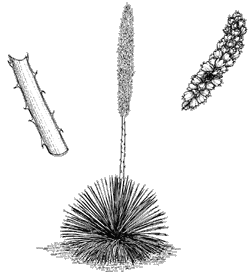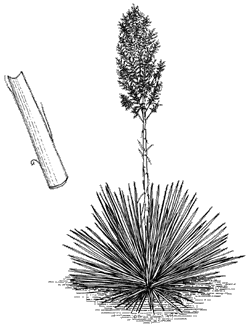Nolinaceae (formerly Agavaceae), nolina family
Dasylirion wheeleri
English name: desert spoon
Spanish names: sotol (sotole is
a palm), sa�o
Description
This perennial evergreen consists of a rosette of hundreds of long, narrow leaves armed with small, sharp, marginal teeth. The rosettes are usually stemless and about 6 feet (2 m) across. Old specimens may develop trunks to 6 feet (2 m) tall, and these sometimes branch. Sotols are dioecious (producing only male or only female flowers on each plant). The inflorescence emerges from the center of the rosette in early summer and grows to 12 feet (3.7 m) tall. Its numerous, dense branches bear thousands of tiny, green- or violet-tinged whitish flowers, followed by winged fruits on female plants. Desert spoon does not die after flowering. The stem branches at the base of the inflorescence and continues growing.
 |
Range
Desert spoon grows on rocky hillsides and slopes at 3000 to 6000 foot (900-1800 m) elevation in southeastern Arizona, southwestern New Mexico, northern and eastern Sonora, Mexico, and to west Texas. Despite its English name, it is primarily a grassland species that extends into the desert.
Comments
The rosettes flower only once in several years. Blooming plants attract huge numbers of insects, including flies, bees, wasps, and butterflies. Until a few decades ago, the Tohono O�odham wove beautiful sleeping mats by plaiting together sotol leaves after removing marginal teeth from the leaves.
Genus Nolina
English names: nolina, beargrass
Spanish names: yuca, sotol, palmita
 |
Nolina bigelovii is the common northern Sonoran Desert species of this genus; it has no vernacular name, save that borrowed from its botanical name� �Bigelow nolina.�The similar N. beldingii occurs in Baja California; you can probably guess its vernacular name. Both resemble desert spoon (Dasylirion) with no marginal teeth on the leaves. The yellowish- to bluish-green rosette of nonsucculent foliage begins at ground level and in an old plant may top a 6 foot (2 m) branched trunk. The tall, densely-branched inflorescence bears thousands of small whitish flowers. But the overall appearance is a greenish plume, drying to an equally attractive straw color.
Comments
The Coahuila Indians ate N. bigelovii flowering stalks after roasting them in pits.










